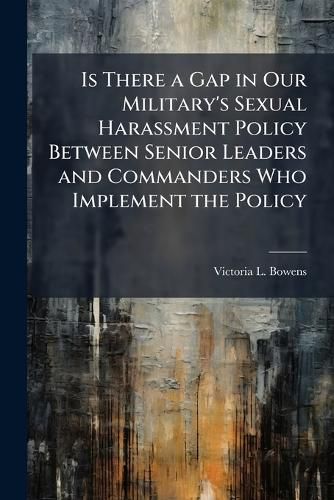Readings Newsletter
Become a Readings Member to make your shopping experience even easier.
Sign in or sign up for free!
You’re not far away from qualifying for FREE standard shipping within Australia
You’ve qualified for FREE standard shipping within Australia
The cart is loading…






The focus of this research paper is to review the Department of Defense's (DOD) current Equal Opportunity (EO) policy and discuss how the policy of sexual harassment "Zero Tolerance" has been implemented in the armed services by senior leaders (0-7 and above). The effectiveness of this policy relies heavily upon the ability of commanders to indoctrinate this policy and influence its intent throughout all levels of their unit. Therefore, the focus of this research it to determine if commanders are implementing and applying the policy of "Zero Tolerance" as it was intended by senior leaders. In order to achieve this focus, the research answers the following questions: Is the policy of "Zero Tolerance" too ambiguous or difficult to manage and do commanders have the appropriate knowledge, tools, and training needed to prevent sexual harassment from occurring within their units. To measure the effectiveness of this policy, I surveyed majors attending the 1998-99 Air Command and Staff College in residence course to validate my thesis: Is there a gap in our military's sexual harassment policy between senior leaders and commanders who implement the policy?
This work has been selected by scholars as being culturally important, and is part of the knowledge base of civilization as we know it. This work was reproduced from the original artifact, and remains as true to the original work as possible. Therefore, you will see the original copyright references, library stamps (as most of these works have been housed in our most important libraries around the world), and other notations in the work.
This work is in the public domain in the United States of America, and possibly other nations. Within the United States, you may freely copy and distribute this work, as no entity (individual or corporate) has a copyright on the body of the work.
As a reproduction of a historical artifact, this work may contain missing or blurred pages, poor pictures, errant marks, etc. Scholars believe, and we concur, that this work is important enough to be preserved, reproduced, and made generally available to the public. We appreciate your support of the preservation process, and thank you for being an important part of keeping this knowledge alive and relevant.
$9.00 standard shipping within Australia
FREE standard shipping within Australia for orders over $100.00
Express & International shipping calculated at checkout
The focus of this research paper is to review the Department of Defense's (DOD) current Equal Opportunity (EO) policy and discuss how the policy of sexual harassment "Zero Tolerance" has been implemented in the armed services by senior leaders (0-7 and above). The effectiveness of this policy relies heavily upon the ability of commanders to indoctrinate this policy and influence its intent throughout all levels of their unit. Therefore, the focus of this research it to determine if commanders are implementing and applying the policy of "Zero Tolerance" as it was intended by senior leaders. In order to achieve this focus, the research answers the following questions: Is the policy of "Zero Tolerance" too ambiguous or difficult to manage and do commanders have the appropriate knowledge, tools, and training needed to prevent sexual harassment from occurring within their units. To measure the effectiveness of this policy, I surveyed majors attending the 1998-99 Air Command and Staff College in residence course to validate my thesis: Is there a gap in our military's sexual harassment policy between senior leaders and commanders who implement the policy?
This work has been selected by scholars as being culturally important, and is part of the knowledge base of civilization as we know it. This work was reproduced from the original artifact, and remains as true to the original work as possible. Therefore, you will see the original copyright references, library stamps (as most of these works have been housed in our most important libraries around the world), and other notations in the work.
This work is in the public domain in the United States of America, and possibly other nations. Within the United States, you may freely copy and distribute this work, as no entity (individual or corporate) has a copyright on the body of the work.
As a reproduction of a historical artifact, this work may contain missing or blurred pages, poor pictures, errant marks, etc. Scholars believe, and we concur, that this work is important enough to be preserved, reproduced, and made generally available to the public. We appreciate your support of the preservation process, and thank you for being an important part of keeping this knowledge alive and relevant.